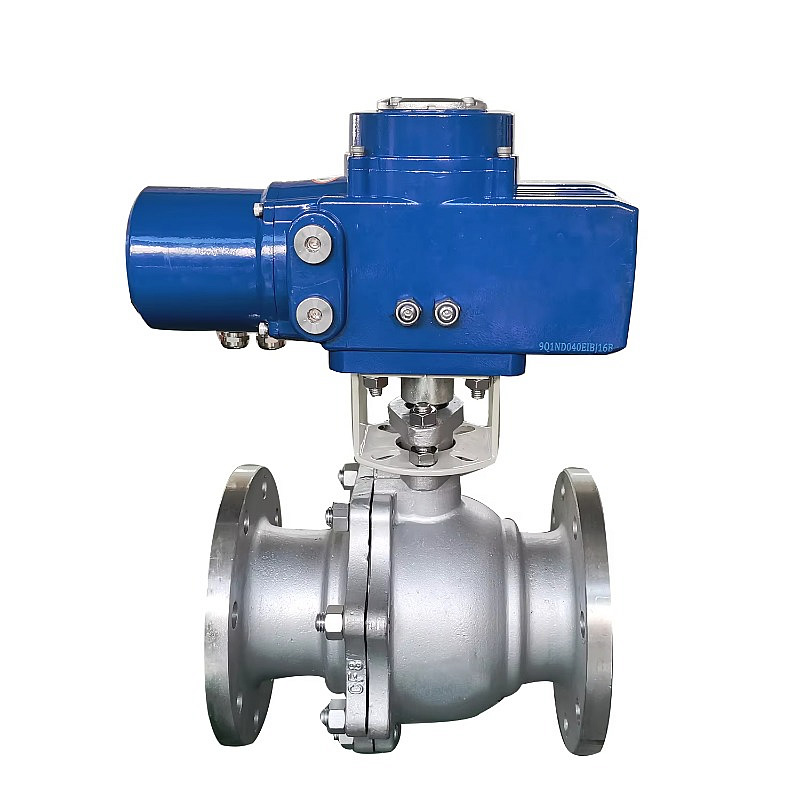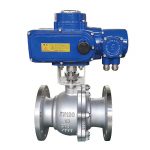TIANYU DN100 PN16 CF8 Electric Actuator Motorized Ball Valve: Stainless Steel Flanged Full-Port Flow Control Solution for Industrial Media with Automated Precision and Reliable Sealing
I. Product Overview
II. Key Attribute Specifications
A. Dimensional & Pressure-Temperature Parameters
- Nominal Diameter (Port Size): DN100 (4 inches), a widely utilized size in industrial pipelines that balances flow capacity and installation flexibility. The full-port design ensures the ball’s bore matches the pipeline’s inner diameter, optimizing flow efficiency—capable of handling up to 200 m³/h of water at 20℃, suitable for medium-scale industrial processes and distribution systems.
- Pressure Rating: PN16 (1.6MPa), aligning with industrial medium-pressure requirements. Hydrostatic testing follows API 598 standards, with the shell tested at 1.5×rated pressure (2.4MPa) and the seat at 1.1×rated pressure (1.76MPa) to verify structural integrity and leak-tight performance.
- Temperature Range: -20℃ to 200℃, enabled by CF8 stainless steel’s thermal stability and compatible sealing materials. This range covers ambient, moderately heated, and low-temperature industrial media, from chilled water to hot oil.
B. Material Composition
- Valve Body & Ball: CF8 stainless steel (ASTM A351), featuring 18-20% chromium and 8-10.5% nickel. This alloy offers excellent corrosion resistance to water, steam, and mild chemicals, while maintaining mechanical strength (tensile strength ≥515MPa, yield strength ≥205MPa) across the operating temperature range.
- Valve Stem: 2Cr13 stainless steel, precision-machined for smooth operation and resistance to wear and corrosion. Equipped with an anti-blowout design to prevent ejection under pressure, enhancing safety.
- Sealing System: Reinforced PTFE (polytetrafluoroethylene) seats, providing chemical inertness and bubble-tight sealing (ANSI/FCI Class VI). PTFE operates reliably from -20℃ to 200℃, ensuring consistent performance.
- Electric Actuator:
- Housing: Aluminum alloy with epoxy powder coating, rated IP65 for dust and water resistance—suitable for industrial environments.
- Motor & Gears: High-efficiency electric motor with precision-engineered gears, delivering torque tailored to the valve’s size for smooth operation.
- Control & Feedback: Options include on-off control, modulating control via 4-20mA signal, and position feedback for integration with SCADA/DCS systems.
C. Connection & Operational Features
- Connection Type: Flanged (Raised Face, RF), complying with ASME B16.5 (Class 150). The RF flange design ensures secure gasket sealing, compatible with spiral-wound or non-asbestos gaskets for various media and temperature conditions.
- Operation Mode: Electric actuation with manual override. The actuator provides 90° rotation for on-off control, with adjustable speed and torque settings. Manual override enables operation during power outages, ensuring process continuity.
- Safety & Control Features: Built-in thermal overload protection to prevent motor burnout; optional explosion-proof certification for hazardous environments; and position indicators for visual status confirmation.
D. Certifications & Compliance
- Industry Standards: API 6D, ASME B16.34, ASME B16.5, API 598.
- Quality Certifications: ISO 9001, CE, ensuring adherence to global quality and safety norms.
- Material Certifications: ASTM A351 (CF8), verifying material composition and performance.
III. Feature Description
A. Electric Actuator: Precision Automation for Industrial Efficiency
B. CF8 Stainless Steel Construction: Corrosion Resistance & Durability
C. Full-Port Ball Design: Efficient Flow & Reduced Pressure Drop
D. Reinforced PTFE Sealing: Bubble-Tight Performance
E. Manual Override & Safety Features: Operational Reliability
IV. Manufacturing Processes

A. Material Inspection & Preparation
- CF8 Stainless Steel Verification: Raw material billets undergo spectral analysis to confirm chemical composition (Cr: 18-20%, Ni: 8-10.5%) and ultrasonic testing to detect internal defects. Mechanical testing (tensile, impact) ensures compliance with ASTM A351 standards.
- Seal Material Testing: PTFE seals are tested for compression set, tensile strength, and chemical resistance at operational temperatures (-20℃ to 200℃) to ensure long-term performance.
B. Valve Body & Ball Machining
- Casting: The valve body and ball are produced via investment casting for CF8 stainless steel, ensuring dimensional accuracy and a smooth surface finish. Castings are heat-treated (solution annealing) to restore corrosion resistance and mechanical properties.
- Machining: CNC turning and milling centers shape the body, ball, and flange faces. Flange faces are machined to flatness tolerance ≤0.05mm/m and surface finish Ra ≤3.2μm for proper gasket seating. The ball is lapped to a surface roughness of Ra ≤0.8μm to ensure uniform seal contact.
C. Actuator Integration & Assembly
- Actuator Assembly: The electric actuator’s motor, gears, and control board are assembled in a cleanroom environment. Gears are lubricated with synthetic grease for quiet operation and long life.
- Valve-Actuator Integration: The actuator is mounted to the valve via an ISO 5211 adapter flange. The drive shaft is connected to the valve stem, with laser alignment to ensure coaxiality and smooth operation.
- Seal Installation: PTFE seals are precision-cut and installed into the valve body, with spring-loading to compensate for thermal expansion and wear.
D. Quality Testing & Certification
- Hydrostatic Testing: The valve undergoes shell and seat tests at 1.5× and 1.1× rated pressure, respectively, with no leakage allowed.
- Operational Testing: The valve is cycled 100 times to verify smooth operation, torque consistency, and seal integrity. The actuator’s thermal overload protection is tested by simulating excessive torque.
- Certification: Each valve is accompanied by material test reports, hydrostatic test reports, and compliance certificates (ISO 9001, CE, API 6D).
V. Product Advantages
A. Automated Precision & Efficiency
B. Corrosion Resistance & Longevity
C. Energy Savings via Full-Port Design
D. Versatile Media Compatibility
E. Safety & Reliability
VI. Product Applications
A. Chemical Processing
- Chemical Transfer Lines: DN100 PN16 valves control the flow of acids, alkalis, and solvents. CF8 stainless steel resists chemical corrosion, while PTFE seals prevent media leakage.
- Reactor Feed Systems: Automated control enables precise dosing of reactants, improving process efficiency and product quality.
B. Energy & Power Generation
- Steam & Condensate Lines: The valve handles saturated steam (up to 200℃) in power plant auxiliary systems. CF8’s thermal stability and PTFE’s high-temperature performance ensure reliable operation.
- Fuel Oil Systems: In diesel or heavy oil pipelines, the valve’s corrosion resistance and tight sealing prevent fuel leakage and contamination.
C. Water & Wastewater Treatment
- Potable Water Distribution: The valve regulates flow in municipal water mains, with CF8 ensuring water quality and PTFE providing leak-tight sealing.
- Wastewater Treatment: Handles sludge and treated water, with the full-port design preventing clogging from solids.
D. Petrochemical & Oil & Gas
- Refined Products Pipelines: Controls the flow of gasoline, diesel, and lubricants. CF8 resists hydrocarbon corrosion, and the electric actuator enables remote monitoring in pipeline networks.
- Gas Distribution: Manages natural gas flow in industrial and commercial systems, with tight sealing to prevent gas leakage.
E. Food & Beverage
- Process Water & CIP Systems: The valve’s sanitary design (CF8 stainless steel, smooth surfaces) meets food-grade requirements for cleaning and process water.
RELATED
-

High Temperature/Pressure 304 Stainless Steel Resistant Manual Power Forged Three Piece Flanged Floating Ball Valve
TIANYU 304 Stainless Steel Flanged Floating Ball Valve: Corrosion-Resistant Full-Port Flow Control Solution for Industrial, Sanitary, and Municipal Me…
BALL VALVE 11/03/2025 -

API ANSI 2in-16in DN50-DN400 PN10 PN16 CF8M Pneumatic Flanged Floating Ball Valve
TIANYU CF8M Pneumatic Flanged Floating Ball Valve: 2in-16in (DN50-DN400) PN10-PN16 API/ANSI Class Corrosion-Resistant Flow Control Solution for Indust…
BALL VALVE 11/01/2025 -

Large-Diameter DN1400 CLASS150 WCB SS Triple Eccentric Metal-Sealed Hard Seal Butterfly Valve
TIANYU DN1400 (56″) CLASS 150 WCB Hard Seal Butterfly Valve: Triple Eccentric Metal-Sealed Flanged Valve for Large-Diameter Industrial Media wit…
BUTTERFLY VALVE 10/30/2025 -

PN16 Stainless Steel Floating Ball Valve: Full Port 2PC Flange-Connected Valve with Fire-Safe & Anti-Static SS Ball Valve
TIANYU Stainless Steel Floating Ball Valve: Full Port 2PC Flange-Connected Valve with Fire-Safe & Anti-Static Design for Oil, Gas, and Industrial …
BALL VALVE 10/29/2025 -

High-Performance DN80 Class 150 WCB Soft-Sealed Lug-Type Double Eccentric Butterfly Valve
TIANYU 3” Class 150 WCB lug-type double eccentric butterfly valve is a technologically advanced flow control device engineered to address the challeng…
BUTTERFLY VALVE 10/25/2025 -

DN125 PN16 CF8M Stainless Steel Lug-Type Butterfly Valve with PTFE Lining Concentric Line Butterfly Valves
TIANYU DN125 PN16 CF8M stainless steel lug-type butterfly valve is a precision-engineered flow control device designed to address the challenges of ha…
BUTTERFLY VALVE 10/25/2025








